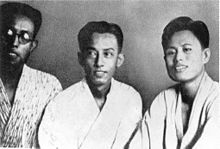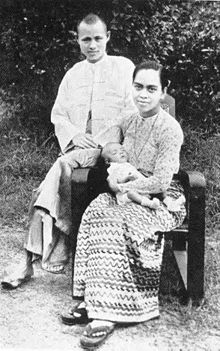Aung San
From Wikipedia, the free encyclopedia
This article is about Aung San. For his daughter, see Aung San Suu Kyi.
- In this Burmese name, Bogyoke is an honorific.
| General Aung San အောင်ဆန်း |
|
|---|---|
 |
|
| Deputy Chairman of the Executive Council of Burma | |
| In office September 1946 – 19 July 1947 |
|
| Preceded by | None |
| Succeeded by | U Nu (as Prime Minister) |
| President of the Anti-Fascist People's Freedom League | |
| In office January 1946 – 19 July 1947 |
|
| Preceded by | None |
| War Minister of Burma | |
| In office 1 August 1943 – 27 March 1945 |
|
| Preceded by | None |
| Personal details | |
| Born | Htein Lin 13 February 1915 Natmauk, Magwe, British Burma |
| Died | 19 July 1947 (aged 32) Rangoon, British Burma |
| Resting place | Martyrs' Mausoleum, Myanmar |
| Nationality | Myanmar |
| Political party | Anti-Fascist People's Freedom League Communist Party of Burma |
| Spouse(s) | Khin Kyi (m. 1942 – w. 1947) |
| Relations | U Pha (father) Daw Suu (mother) Ba Win (brother) Sein Win (nephew) |
| Children | Aung San Oo Aung San Lin Aung San Suu Kyi |
| Alma mater | Rangoon University Yenangyaung High School |
| Occupation | Politician, Soldier |
| Religion | Theravada Buddhism |
| Military service | |
| Nickname(s) | Buffalo General[citation needed] |
| Allegiance | Burma National Army Anti-Fascist People's Freedom League Communist Party of Burma |
| Rank | Major General (highest rank in military at that time) |
| History of Burma |
|---|
 |
|
|
|
|
He was a founder of the Communist Party of Burma and was instrumental in bringing about Burma's independence from British colonial rule in Burma, but was assassinated six months before independence. He is recognized as the leading architect of independence, and the founder of the Union of Burma. Affectionately known as "Bogyoke" (General), Aung San is still widely admired by the Burmese people, and his name is still invoked in Burmese politics to this day.
Aung San had a daughter, Aung San Suu Kyi, who is a Burmese politician and the recipient of a Nobel Peace Prize.
Contents |
Youth
Aung San was born to U Pha, a lawyer, and his wife, Daw Suu, in Natmauk, Magway District, in central Burma on 13 February 1915. His family was already well known in the Burmese resistance movement; his great uncle Bo Min Yaung fought against the British annexation of Burma in 1886.Aung San received his primary education at a Buddhist monastic school in Natmauk, and secondary education at Yenangyaung High School. He went to Rangoon University (now the University of Yangon) and received a B.A. degree in English Literature, Modern History, and Political Science in 1938.
Names of Aung San
- Name at birth: Htein Lin (ထိန်လင်း)
- As student leader and a thakin: Aung San (သခင်အောင်ဆန်း)
- Nom de guerre: Bo Teza (ဗိုလ်တေဇ)
- Japanese Name: Omoda Monji (面田紋次)
- Chinese Name: Tan Lu Sho
- Resistance period code name: Myo Aung (မျိုးအောင်), U Naung Cho (ဦးနောင်ချို)
- Contact code name with General Ne Win: Ko Set Pe (ကိုစက်ဖေ)
Struggle for independence
After Aung San entered Rangoon University in 1933, he quickly became a student leader.[1] He was elected to the executive committee of the Rangoon University Students' Union (RUSU). He then became editor of their magazine Oway (Peacock's Call).[2]In February 1936, he was threatened with expulsion from the university, along with U Nu, for refusing to reveal the name of the author of the article Hell Hound At Large, which criticized a senior University official. This led to the Second University Students' Strike and the university authorities subsequently retracted their expulsion orders. In 1938, Aung San was elected president of both the Rangoon University Student Union (RUSU) and the All-Burma Students Union (ABSU), formed after the strike spread to Mandalay.[2][3] In the same year, the government appointed him as a student representative on the Rangoon University Act Amendment Committee.
He also helped found another nationalist organization, the Freedom Bloc (ဗမာ့ထွက်ရပ်ဂိုဏ်း, Bama-htwet-yat Gaing), by forming an alliance between the Dobama, the ABSU, politically active monks and Dr Ba Maw's Sinyètha (Poor Man's) Party, and became its general secretary. What remains relatively unknown is the fact that he also became a founder member and first secretary-general of the Communist Party of Burma (CPB) in August 1939.[citation needed] Shortly afterwards he co-founded the People's Revolutionary Party, renamed the Socialist Party after the Second World War.[2] In March 1940, he attended the Indian National Congress Assembly in Ramgarh, India. However, the government issued a warrant for his arrest due to Thakin attempts to organize a revolt against the British and he had to flee Burma.[3] He went first to China, seeking assistance from the nationalist government of the Kuomintang,[4] but he was intercepted by the Japanese military occupiers in Amoy, and was convinced by them to go to Japan instead.[2]
World War II period
The former capital of Burma, Rangoon (now Yangon), fell to the Japanese in March 1942 (as part of the Burma Campaign in World War II). The BIA formed an administration for the country under Thakin Tun Oke that operated in parallel with the Japanese military administration until the Japanese disbanded it. In July, the disbanded BIA was re-formed as the Burma Defense Army (BDA). Aung San was made a colonel and put in charge of the force.[3] He was later invited to Japan, and was presented with the Order of the Rising Sun by Japanese Emperor Hirohito.[3]
On 1 August 1943, the Japanese declared Burma to be an independent nation. Aung San was appointed War Minister, and the army was again renamed, this time as the Burma National Army (BNA).[3] Aung San became skeptical of Japanese promises of true independence and of Japan's ability to win the war. As William Slim, 1st Viscount Slim put it "It was not long before Aung San found that what he meant by independence had little relation to what the Japanese were prepared to give - that he had exchanged an old master for an infinitely more tyrannical new one. As one of his leading followers once said to me, 'If the British sucked our blood, the Japanese ground our bones!' He became more and more disillusioned with the Japanese, and early in 1943 we got news from Seagrim, a most gallant officer who had remained in the Karen Hills at the ultimate cost of his life, that Aung San's feelings were changing. On the 1st August 1944 he was bold enough to speak publicly with contempt of the Japanese brand of independence, and it was clear that, if they did not soon liquidate him, he might prove useful to us...At our first interview, Aung San began to take rather a high hand...I pointed out that he was in no position to take the line he had. I did not need his forces; I was destroying the Japanese quite nicely without their help, and could continue to do so. I would accept his help and that of his army only on the clear understanding that it implied no recognition of any provisional government...The British Government had announced its intention to grant self-government to Burma within the British Commonwealth, and we had better limit our discussion to the best method of throwing the Japanese out of the country..."[6] He made plans to organize an uprising in Burma and made contact with the British authorities in India, in cooperation with Communist leaders Thakin Than Tun and Thakin Soe. On 27 March 1945, he led the BNA in a revolt against the Japanese occupiers and helped the Allies defeat the Japanese.[2] 27 March came to be commemorated as 'Resistance Day' until the military regime later renamed it 'Tatmadaw (Armed Forces) Day'.
Post-World War II
After the return of the British, who had established a military administration, the Anti-Fascist Organisation (AFO), formed in August 1944, was transformed into a united front, comprising the BNA, the Communists and the Socialists, and renamed the Anti-Fascist People's Freedom League (AFPFL). The Burma National Army was renamed the Patriotic Burmese Forces (PBF) and then gradually disarmed by the British as the Japanese were driven out of various parts of the country. The Patriotic Burmese Forces, while disbanded, were offered positions in the Burma Army under British command according to the Kandy conference agreement with Lord Louis Mountbatten in Ceylon in September 1945.[2] Aung San was offered the rank of Deputy Inspector General of the Burma Army, but he declined it in favor of becoming a civilian political leader and the military leader of the Pyithu yèbaw tat (People's Volunteer Organisation or PVO).[2]In January 1946, Aung San became the President of the AFPFL following the return of civil government to Burma the previous October. In September, he was appointed Deputy Chairman of the Executive Council of Burma by the new British Governor Sir Hubert Rance, and was made responsible for defence and external affairs.[2] Rance and Mountbatten took a very different view from the former British Governor, Sir Reginald Dorman-Smith, and also Winston Churchill, who had called Aung San a 'traitor rebel leader'.[2] A rift had already developed inside the AFPFL between the Communists and Aung San, leading the nationalists and Socialists, which came to a head when Aung San and others accepted seats on the Executive Council, culminating in the expulsion of Thakin Than Tun and the CPB from the AFPFL.[2][3]
Aung San was to all intents and purposes Prime Minister, although he was still subject to a British veto. On 27 January 1947, Aung San and the British Prime Minister Clement Attlee signed an agreement in London guaranteeing Burma's independence within a year; Aung San had been responsible for its negotiation.[2] During the stopover in Delhi at a press conference, he stated that the Burmese wanted 'complete independence' not dominion status and that they had 'no inhibitions of any kind' about 'contemplating a violent or non-violent struggle or both' in order to achieve this, and concluded that he hoped for the best but he was prepared for the worst.[3]
Two weeks after the signing of the agreement with Britain, Aung San signed an agreement at the Panglong Conference on 12 February 1947 with leaders from other national groups, expressing solidarity and support for a united Burma.[2][7] Karen representatives played a relatively minor role in the conference and, as subsequent rebellions revealed, remained alienated from the new state. U Aung Zan Wai, U Pe Khin, Major Aung, Sir Maung Gyi, Dr. Sein Mya Maung , Myoma U Than Kywe were among the negotiators of the historical Panglong Conference negotiated with Bamar representative General Aung San and other ethnic leaders in 1947. All these leaders unanimously decided to join the Union of Burma.
In general elections held in April 1947, the AFPFL won 176 out of 210 seats in the election for a Constituent Assembly, while the Karens won 24, the Communists 6 and Anglo-Burmans winning 4.[8] In July, Aung San convened a series of conferences at Sorrenta Villa in Rangoon to discuss the rehabilitation of Burma.
Assassination
On 19 July 1947, a gang of armed paramilitaries of former Prime Minister U Saw[citation needed] broke into the Secretariat Building in downtown Rangoon during a meeting of the Executive Council (the shadow government established by the British in preparation for the transfer of power) and assassinated Aung San and six of his cabinet ministers, including his older brother Ba Win, father of Sein Win leader of the government-in-exile, the National Coalition Government of the Union of Burma (NCGUB). A cabinet secretary and a bodyguard were also killed. U Saw was subsequently tried and hanged.Many mysteries still surround the assassination. There were rumours of a conspiracy involving the British — a variation on this theory was given new life in an influential, but sensationalist, documentary broadcast by the BBC on the 50th anniversary of the assassination in 1997. What did emerge in the course of the investigations at the time of the trial, however, was that several low-ranking British officers had sold guns to a number of Burmese politicians, including U Saw. Shortly after U Saw's conviction, Captain David Vivian, a British Army officer, was sentenced to five years imprisonment for supplying U Saw with weapons. Captain Vivian escaped from prison during the Karen uprising in Insein in early 1949. Little information about his motives was revealed during his trial or after the trial.[9]












 Myanmar Kyat Converter
Myanmar Kyat Converter တေနရာတည္း၌ ဂ်ာနယ္ေပါင္းစုံေဒါင္းရန္
တေနရာတည္း၌ ဂ်ာနယ္ေပါင္းစုံေဒါင္းရန္
0 comments:
Post a Comment